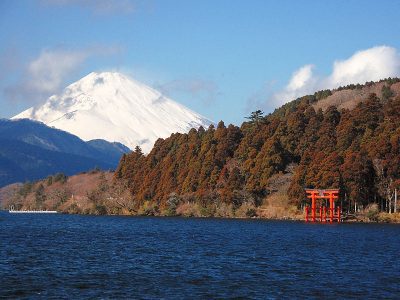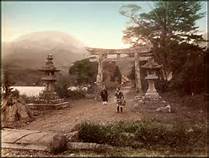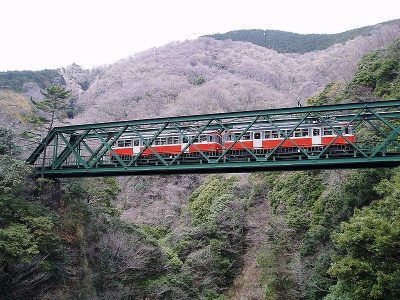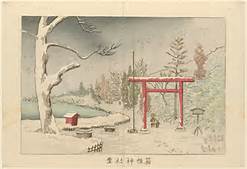Tourist treat based on culture, history, and stunning landscapes on the doorstep of Tokyo
Kanako Itamae and Lee Jay Walker
Modern Tokyo Times

Hakone is a very popular tourist destination because you have so many places to visit and the views of Mount Fuji in certain locations are extremely stunning. Throughout Hakone, you have many museums, art galleries, and cultural wise the area is very rich in history. This certainly applies to Hakone Jinja (Hakone Shrine), whereby the Shinto faith blends naturally with nature. Also, the historical treasure museum based on the rich history of Hakone Jinja is certainly worth visiting because you have several amazing gems.
Hakone Jinja (Hakone Gongen) highlights all the natural beauty of Shinto and how nature and the gods work in unison in this religion. The backdrop of Lake Ashi, the mountain landscape, and Mount Fuji breaking out from certain vantage points is absolutely stunning. Therefore, you can feel the strong connection between nature and the mystical charms of the Shinto faith.

The exact date when the foundation of Hakone Shrine was created remains debatable but it dates back to at least the eighth century. This means that this amazing religious place was built during the Nara Period (710-794) and this is extremely fitting. After all, while Kyoto may hog the limelight for being significant in Japanese culture the truth of the matter is that the Nara Period is where high culture began.
Mystical holy men in the eighth century called yamabushi believed that gods dwelled in mountains that were extremely steep. Given this reality, by dwelling in the same places it was hoped that ascetic practices – fused with the dwelling gods – would lead to magical powers and bestow greater knowledge. Not surprisingly, Hakone Jinja with its ideal location and mysterious majesty became a place where the dwelling gods could be found according to the traditions of the yamabushi.
During the ninth century, new forces were entering the Japanese psyche because Esoteric Buddhism from China was making inroads. This notably applies to Kukai (774-835) and Saicho (767-822). Naturally, this gave further importance to mountain landscapes. Therefore, a fusion began to take place based on the Shinto faith, its animistic nature and esoteric Buddhism in parts of Japan.

Mountain asceticism under Kukai in Wakayama was also powerful. Meanwhile, in eastern Japan, and this notably applies to Hakone and Nikko, the same asceticism could be found despite the thought patterns being different. According to history, the Priest Mangan traveled extensively to spread the Buddhist faith. In 757 he reached Hakone and during his stay, various powerful events occurred that impinged on his life. This notably applies to having many encounters with the yamabushi during his three years in Hakone. Hence, Priest Mangan learned about new ascetic ways. However, the real lasting legacy applies to a revelation that Priest Mangan had.
In this revelation – that occurred during a dream – the fusion of many ideas manifested itself whereby the outcome was very important. The revelation in his dream states, “Your heart is pure and clean. Let’s deliver mankind with the grace of Shinto and Buddhist deities.” This revelation impacted greatly on him because he notified the emperor who in turn valued the meaning. Therefore, the emperor notified Priest Mangan to build a shrine at once in order to fulfill the revelation and hence this is the origin of this holy Shinto shrine.

Issues related to when the foundations first began or if Priest Mangan incorporated older Shinto shrines remains open to debate. However, major changes did occur during the stay of Priest Mangan. After this momentous change, many powerful individuals in Japanese history understood the power of this holy place.
If you visit the small Treasure Museum associated with the Hakone Jinja you will soon understand the power and influence of this enlightened area. This applies to the linkage with Emperor Hanayama (968-1008), Yoritomo Minamoto (1147-1199), Toyotomi Hideyoshi who died in 1598, Tokugawa Ieyasu (1543-1616), and many other powerful figures in Japanese history. Hence, while the Treasure Museum may only be small, you still have many gems inside. This notably applies to five items that have been ranked with having national Important Cultural Property.

Hakone is an extremely beautiful part of Japan and takes only 90 minutes by a special express train from Shinjuku. Also, the special Hakone transport pass from the Odakyu train company means that your stay is convenient based on the usage of several modes of transport.
Hakone is situated in the Fuji Hakone Izu National Park and the entire region is a tourist paradise because stunning nature abounds in all directions. On top of this, you have so many cultural treasures to view and the same applies to holy Buddhist temples and Shinto shrines. Cultural tourism applies to the Narukawa Art Museum for modern Japanese paintings; the Hakone Open Air Museum; the Pola Museum of Art; Venetian Glass Museum; Suzuhiro Corp. Kamaboko Museum; volcanically active Owakudani geysers; Hakone Botanical Garden of Wetlands; Odawara Castle Donjon; Local History Museum; Museum of Saint Exupery and the Little Pince in Hakone; Hakone Old Takaido Road Museum; Hakone Mononofu-no-Sato Art Museum; Hakone Art Museum; Honma Yosegi Museum; the Kanagawa Prefectural Museum of Natural History; and a wealth of parks and special walks to enjoy your stay.

Modern Tokyo News is part of the Modern Tokyo Times group
DONATIONS to SUPPORT MODERN TOKYO TIMES – please pay PayPal and DONATE to sawakoart@gmail.com
http://moderntokyotimes.com Modern Tokyo Times – International News and Japan News
http://sawakoart.com – Sawako Utsumi personal website and Modern Tokyo Times artist
https://moderntokyonews.com Modern Tokyo News – Tokyo News and International News
http://global-security-news.com Global Security News – Geopolitics and Terrorism
PLEASE JOIN ON TWITTER
https://twitter.com/MTT_News Modern Tokyo Times
PLEASE JOIN ON FACEBOOK